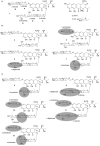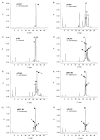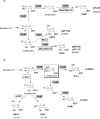Generation of new derivatives of the antitumor antibiotic mithramycin by altering the glycosylation pattern through combinatorial biosynthesis
- PMID: 18756551
- PMCID: PMC2574993
- DOI: 10.1002/cbic.200800299
Generation of new derivatives of the antitumor antibiotic mithramycin by altering the glycosylation pattern through combinatorial biosynthesis
Abstract
Mithramycin is an antitumor drug produced by Streptomyces argillaceus. It consists of a tricyclic aglycone and five deoxyhexoses that form a disaccharide and a trisaccharide chain, which are important for target interaction and therefore for the antitumor activity. Using a combinatorial biosynthesis approach, we have generated nine mithramycin derivatives, seven of which are new compounds, with alterations in the glycosylation pattern. The wild-type S. argillaceus strain and the mutant S. argillaceus M7U1, which has altered D-oliose biosynthesis, were used as hosts to express various "sugar plasmids", each one directing the biosynthesis of a different deoxyhexose. The newly formed compounds were purified and characterized by MS and NMR. Compared to mithramycin, they contained different sugar substitutions in the second (D-olivose, D-mycarose, or D-boivinose instead of D-oliose) and third (D-digitoxose instead of D-mycarose) sugar units of the trisaccharide as well as in the first (D-amicetose instead of D-olivose) sugar unit of the disaccharide. All compounds showed antitumor activity against different tumor cell lines. Structure-activity relationships are discussed on the basis of the number and type of deoxyhexoses present in these mithramycin derivatives.
Figures




References
-
- Fu X, Albermann C, Jiang J, Liao J, Zhang C, Thorson JS. Nat. Biotechnol. 2003;21:1467–1469. - PubMed
-
- Losey HC, Jiang J, Biggins JB, Oberthur M, Ye XY, Dong SD, Kahne D, Thorson JS, Walsh CT. Chem. Biol. 2002;9:1305–1314. - PubMed
-
- Salas JA, Méndez C. Trends Microbiol. 2007;15:219–232. - PubMed
-
- Yang M, Proctor MR, Bolam DN, Errey JC, Field RA, Gilbert HJ, Davis BG. J. Am. Chem. Soc. 2005;127:9336–9337. - PubMed
-
- Rohr J, Méndez C, Salas JA. Bioorg. Chem. 1999;27:41–54.
Publication types
MeSH terms
Substances
Grants and funding
LinkOut - more resources
Full Text Sources
Other Literature Sources
Medical
Molecular Biology Databases

